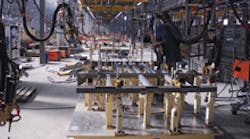Linear actuators achieve precision motion control with little to no backlash
Authored by: |
Consider a traditional rack-and-pinion system. It consists of a toothed circular pinion that engages the teeth on a flat rail, converting rotary to linear motion. Now consider what’s called a roller-pinion system. It still has the pinion/rack combination, but the teeth on the pinion are replaced with bearing-supported rollers that engage a unique tooth profile. Each tooth is precisely measured relative to the first, eradicating cumulative error and maintaining high positional accuracy. The result is accurate positioning up to ±30 µm (±0.00118 in.) — within half the diameter of a human hair — at speeds up to 11 m/sec (36.1 fps).
Roller pinions come in handy for delivering high accuracy, but they also eliminate backlash because two or more rollers connect in opposition with the rack teeth at all times. The rollers approach the tooth face on a tangent path and then smoothly roll down the face. This action is much less noisy than that of ball and tooth slap associated with traditional rack-and-pinion systems. The low-friction design can approach 99% efficiency converting rotary to linear motion, reducing wear and providing a long service life — even when working at extremely high speeds. Plus, the robust tooth profile and large bearing-surface design leads to systems that are stiffer than those delivered by ball and roller screws.
One reason roller-pinion systems can be stiff is that there are versions of pinions available that directly mount to a gearhead. The direct-mount pinions are rigidly secured close to the drive bearings with no bushings or shafts in between.
In addition, machine builders can purchase roller-pinion systems in standard segment lengths and custom cut them as needed. There is also some flexibility in the cost of these devices because roller pinions come in numerous models, each delivering different accuracies, life expectancies, maximum dynamic loads, lubrication needs, and corrosion resistance.
For instance, a given size product in a premium model may deliver the highest positional accuracy of ±30 µm, a high life expectancy of 30 million cycles/tooth and a maximum dynamic load (N) of 1,000. For medium loads, a universal model can deliver accuracy of ±50 µm for 5 million cycles/tooth and carry a maximum dynamic load (N) of 750.
A few examples help to illustrate how roller pinions play a role in specific applications. In one case, a machine builder installed a roller-pinion system in a machine that nondestructively tested aerospace carbon-fiber forms such as wing sections. While a low-backlash rack-and-pinion system might have cost less, accuracy and repeatability over the life of the machine could have been an issue. The result would have been difficulty in syncing drives as system wear caused progressively more accumulated error. The roller-pinion system solved these issues, providing a mechanical resolution that complemented the sophisticated drive-control system with good positioning accuracy.
Roller-pinion systems need less maintenance than conventional rack-and-pinion setups. A higher sectional wear rate can be seen when the motion profile is tight, as in this example. Long rack-and-pinion sections are more difficult to replace than segmented roller-pinion racks. In addition, low-backlash rack-and-pinion sections are cut in pairs. So when the time comes for their replacement, maintenance workers would have to replace two rack-and-pinion sections instead of a single roller-pinion.
Roller-pinion systems adapt well to plasma-cutting machines, which have applications in almost every industry. Here, the high precision of roller pinions is their biggest advantage. Less-precise systems, such as a traditional rack and pinion, may cause uneven cuts that need additional machining and more overall time and work.
Higher-precision roller pinions also let users apply laser technology in areas that once were impractical. And though rack and pinions carry a lower initial price tag, experience shows they may need replacement as frequently as every three months in plasma-cutting uses.
Another application that needs accurate motion control (in a rotary form) is a precision tube-welding machine. The machine welds multiple rotating pieces to form one large tube. Again, a roller-pinion system can be more accurate and precise than a traditional gear system and last longer.
